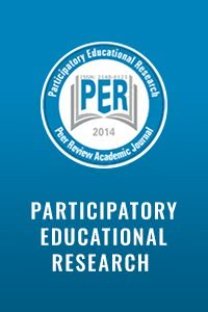Adaptation of scale “Working Like Scientists” (WLS) A Turkish-language version: validation and reliability
___
- Aikenhead, G. S., & Ryan, A. G. (1992). The Development of a New Instrument: “Views on Science- Technology-Society” (VOSTS). Science Education, 76(5), 477–491. http://doi.org/10.1002/sce.3730760503
- Aikenhead, G. S., Ryan, A. G., & Fleming, R. W. (1989). Views on science-technology society. Retrieved from http://www.usask.ca/education/profiles /aikenhead/webpage/vosts.pdf
- Bybee, R. (2000). Teaching science as inquiry. In J. Minstrell & E. van Zee (Eds.), Inquiring into inquiry learning and teaching in science (pp. 20–46). Washington: American Association for the Advancement of Science.
- DeBacker, T. K., Crowson, H. M., Beesley, A. D., Thoma, S. J., & Hestevold, N. L. (2008). The Challenge of Measuring Epistemic Beliefs: An Analysis of Three Self-Report Instruments. The Journal of Experimental Education, 76(3), 281–312. http://doi.org/10.3200/JEXE.76.3.281-314
- Deryakulu, D., & Bıkmaz, H. F. (2003). Bilimsel Epistemolojik İnançlar Ölçeğinin Geçerlik ve Güvenirlik Çalışması [The Validity And Reliability Study Of The Scientific Epistemological Beliefs Survey]. Eğitim Bilimleri ve Uygulama Dergisi, 2(4), 243–257.
- Hofer, B. K. (2001). Personal epistemology research: Implications for learning and teaching. Journal of Educational Psychology Review, 13(4), 353–383.
- Hofer, B. K., & Pintrich, P. R. (1997). The develop- ment of epistemological theories: Beliefs about knowledge and knowing and their relation to learning. Review of Educational Research, 67(1), 88 – 140.
- Fornell, C., Larcker, D.F., 1981. Evaluating structural equation models with unobservable variables and measurement error. Journal of Marketing Research, 18 (1), 39-50.
- Hambleton, R.K., & Patsula, L. (1999). Increasing the validity of adapted tests: Myths to be avoided and guidelines for improving test adaptation practices. Journal of Applied Testing Technology, 1(1), 1-30.
- Höner, K, Strahl, A., Müller, R., Eghtessad, A., Pietzner, V., Looß, M., Klingenberg, K. & E. Gläser (2010). Das Wissenschaftsverständnis von Lehramtsstudierenden [Epistemological Belifs of Teacher Candidates], chim. & ct. did., 103 (36). Jg., 39-66.
- Lederman, N. G., Abd-El-Khalick, F., Bell, R. L., & Schwartz, R. S. (2002). Views of nature of science questionnaire: Toward valid and meaningful assessment of learners’ conceptions of nature of science. Journal of Research in Science Teaching, 39 (6), 497–521. http://doi.org/10.1002/tea.10034
- [National Research Council], NRC. (1996). National Science Education Standards. National Academies Press.
- Neumann, I., & Kremer, K. (2013). Nature of Science und epistemologische Überzeugungen Ähnlichkeiten und Unterschiede. Zeitschrift Für Didaktik Der Naturwissenschaften, 19, 211–234.
- Nunnally, J. C. & Bernstein, I. H. (1994). Psychometric theory. 3rd Edition. McGraw-Hill: New York.
- Ordonez, X. G., Ponsoda, V., Abad, F. J., & Romero, S. J. (2008). Measurement of Epistemological Beliefs: Psychometric Properties of the EQEBI Test Scores. Educational and Psychological Measurement, 69 (2), 287–302. http://doi.org/10.1177/0013164408323226
- Pomeroy, D. (1993). Implications of teachers' beliefs about the nature of science: Comparison of the beliefs of scientists, secondary science teachers, and elementary teachers. Science Education, 77 (3), 261-278.
- Schommer, M. A. (1990). Effects of beliefs about the nature of knowledge on comprehension. Journal of Educational Psychology, 82 (3), 498 – 504.
- Schraw, G. (2013). Conceptual Integration and Measurement of Epistemological and Ontological Beliefs in Educational Research. ISRN Education, 19. http://doi.org/10.1155/2013/327680
- Schraw, G., Bendixen L.D. & Dunkle M.E. (2002). Development and validation of the epistemic belief inventory (EBI). In: Hofer BK, Pintrich PR, Eds. Personal Epistemology: The Psychology of Beliefs About Knowledge and Knowing. 1st ed. New Jersey: Erlbaum, 261-75.
- Schwartz, R. S., Lederman, N. G., & Lederman, J. S. (2008). An Instrument To Assess Views Of Scientific Inquiry: The VOSI Questionnaire. Annual Meeting of the National Association for Research in Science Teaching, 1–24. Retrieved from http://homepages.wmich.edu/~rschwart/
- Schwartz, R. S., Lederman, N. G., & Crawford, B. A. (2004). Developing views of nature of science in an authentic context: An explicit approach to bridging the gap between nature of science and scientific inquiry. Science Education, 88 (4), 610–645. http://doi.org/10.1002/sce.10128
- Stahl, E. & R. Bromme, R. (2007). “CAEB: an instrument for measuring connotative aspects of epistemological beliefs,” Learning and Instruction, 17 (6), 773 - 785.
- Steiger, J. H. (1990). Structural model evaluation and modification: an interval estimation approach. Multivariate Behavioral Research, 25 (2), 173-80.
- Tsai, C. (2000). Relationships between student scientific epistemological beliefs and perceptions of constructivist learning environments. Educational Research, 42 (2), 193–205. http://doi.org/10.1080/001318800363836
- Welch, A. G., Roy, C. M., & Ray, C. M. (2012). A preliminary report of the psychometric properties of the Epistemic Beliefs Inventory. The European Journal of Social & Behavioural Sciences, 2301–2218. http://doi.org/10.15405/ FutureAcademy/ejsbs(2301-2218).2012.2.12
- Wood, P., & Kardash, C. (2002). Critical elements in the design and analysis of studies of epistemology. In B. . Hofer & P. R. Pintrich (Eds.), Personal epistemology: The psychology of beliefs about knowledge and knowing (pp. 231–260). Mahwah, NJ: Erlbaum.
- Yıldırım, C. (2007). Bilim Felsefesi[Philosophy of Science]. 11. Ed., İstanbul: Remzi Kitapevi.
- ISSN: 2148-6123
- Yayın Aralığı: Yılda 6 Sayı
- Başlangıç: 2014
- Yayıncı: Özgen KORKMAZ
Güntay TAŞÇI, Maike LOOSS, Halil YURDUGÜL, Dagmar Hilfert RUPPELL, Ali SÜLÜN, Dagmar HİNRİCHS, Sedat AYDOĞDU, Konstantin KLİNGENBERG, Fehime Şeyma TAŞ
Güneş UĞRAŞ, Ahmet Murat UZUN, Ali BATTAL, Halil KAYADUMAN
Betül Ayşe SAYIN, Musa Mükerrem ASLAN
Hülya KARTAL, Yakup BALANTEKİN, Asude BİLGİN
Agâh Tuğrul KORUCU, Ahmet YÜCEL, Mustafa M. GÜNDOĞDU, Tarık GENÇTÜRK
